 | First Steps Matter: Empowering Early Years Workers to Build Human CapitalAmid heightened geopolitical tensions, the Philippines’ economy is expected to remain robust, growing at an average rate of 6.0 percent over 2024-2026 and sustaining poverty reduction. Full Report | Infographic | Report Launch Event Replay (December 12, 2024) Press Release: Philippines’ Economy Maintains Strength Amid Global Geopolitical Tensions Press Release: Empowering Local Governments Key to Boosting Human Capital in the Philippines
|
 | Beyond the Numbers: Sustaining Poverty Reduction in BARMM (June 2024)The Philippine economy is forecast to accelerate to 5.8% growth in 2024 from 5.5% last year and to 5.9% in 2025. Growth is expected to be driven by strong household consumption, sustained strength in the services sector, and improved trade stemming from a rebound in global demand for goods and the continued recovery of services exports such as tourism. Full Report | Infographic | Report Launch Event Replay Slide Presentation of the Growth Outlook for the Philippines | Slide Presentation of the special focus on sustaining poverty reduction in the BARMM Press Release: Bolstering Resilience Against Climate Change Key to Sustaining Inclusive Growth Press Release: Boosting Farm Profitability, Access to Social Services, Infrastructure Key to Poverty Reduction, Lasting Peace in Bangsamoro |
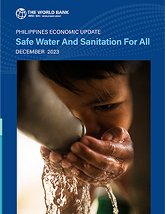 | December 2023: Safe Water and Sanitation for AllFully implementing key reforms to bolster private investments is crucial for sustaining growth and boosting job creation in the Philippines amid challenges including high inflation, elevated interest rates, sluggish international trade, and global uncertainties associated with Russia’s invasion of Ukraine and conflict in the Middle East. Full Report | Report Launch Event Replay (7 December 2023) Press Release: Implementing Reforms to Boost Private Investment Key to Sustained Job Creation and Poverty Reduction in the Philippines Press Release: Municipalities and Cities Need Strong National Government Support to Ensure Safe Water and Sanitation for All Filipinos |
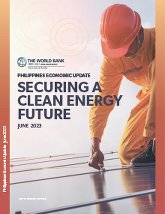 | June 2023: Securing a Clean Energy FutureImproving the efficiency of social protection in the Philippines remains essential to protect the poor and most vulnerable from economic shocks as the country grapples with global uncertainties and domestic risks including high inflation. Bucking global trends, strong domestic demand in the Philippines is expected to propel its economy to a 6.0 percent growth in 2023 and 5.9 percent the following year. Strong domestic demand is underpinned by consumer spending drawing strength from the continuing jobs recovery and the steady flow of remittances. Fixed capital investment will also contribute to growth, anchored on upbeat domestic activity, and improved business confidence.
Full Report | Report Highlights | Press Release | Report Launch Event Replay on 8 June 2023 | Economic Update Slide Presentation | Energy Transition Slide Presentation |
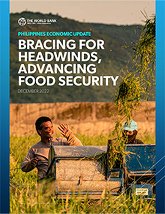 | December 2022: Bracing for headwinds, Advancing Food SecurityThe December 2022 edition of the PEU includes a special focus on the topic of Public Expenditure Review for Agriculture and lays out the importance of improving the effectiveness of public spending in the sector. It also looks into the financial and functional devolution resulting from the Mandanas ruling and the challenges and policy recommendations toward achieving the medium to long term agenda of agriculture productivity and food security. |
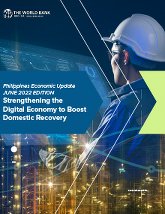 | June 2022: Strengthening the Digital Economy to Boost Domestic RecorveryAnchored on more robust domestic activities, the Philippines is poised to grow 5.7 percent in 2022 and 5.6 percent on average in 2023-24 amidst intensifying global uncertainties. Continuity of policies supporting growth and investments are key to strengthening recovery in the Philippines. |
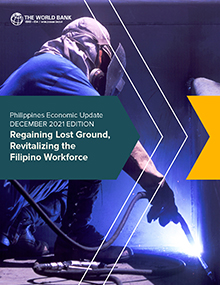 | December 2021 Regaining Lost Ground, Revitalizing the Filipino WorkforceFrom the deep economic contraction last year, the Philippines is on the path to economic recovery. There are clear signs of rebounds in domestic activity, community mobility, industrial output, and recently with bank lending activities. However, there are challenges to growth with the continuing threat of the pandemic amid narrowing policy space. The key policy challenges are to protect long term fiscal sustainability, leverage the private sector in the recovery, and limit the economic scarring from the pandemic. Full Report | Press Release "PHILIPPINES: Boosting Private Sector Growth Can Strengthen Recovery, Create More Jobs" | Report launch Replay |
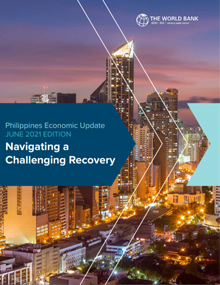 | June 2021 Navigating a Challenging RecoveryWeighed down by the COVID-19 pandemic, the Philippine economy is forecast to grow at 4.7 percent this year before accelerating to 5.9 percent in 2022 and 6.0 percent in 2023. Local governments have played a crucial role at the front lines of the COVID crisis. A current lack of resources prevents local government units (LGUs) from fulfilling their devolved mandates. Full Report | Key Findings | Press Release: Ramping Up Vaccination, Improving Pandemic Response Can Strengthen Recovery Report Launch Replay | Press Release: Mandanas Ruling Provides Opportunities for Improving Service Delivery Through Enhanced Decentralization |
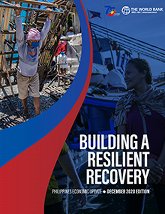 | December 2020: Building a Resilient RecoveryThe multiple shocks that hit the Philippines – the COVID-19 health crisis, economic activities across the country frozen by quarantine measures, devastating typhoons in November, and the global recession – will likely shrink the economy by 8.1 percent in 2020, temporarily reversing gains made in poverty reduction in recent years. Sustained improvements in managing the pandemic and a possible rebound in the global economy, however, can help the country recover in 2021 and 2022. |
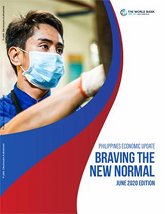 | June 2020: Braving the New NormalHammered by natural disasters and COVID-19, the Philippine economy is projected to contract by 1.9 percent in 2020. But there are good chances that the country can bounce back in the next two years. |
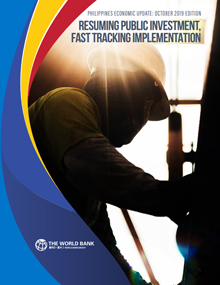 | October 2019: Resuming Public Investment, Fast Tracking ImplementationHigh impact projects and critical reforms are key to regaining higher growth. Press Release | Report Highlights | Full Report (pdf) |
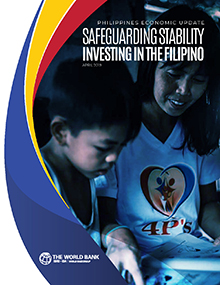 | April 2019: Safeguarding Stability, Investing in the FilipinoAmidst lingering global and local uncertainties, the Philippine economy is poised to grow at 6.4 percent in 2019 and 6.5 percent in 2020 and 2021. Highlights | Full Report (pdf) |
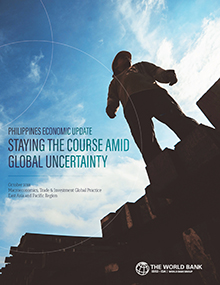 | October 2018: Staying in the Course Amid Global UncertaintyAmidst rising global uncertainty and inflationary pressures, the Philippine economy is poised to remain strong and is projected to grow at 6.5 percent in 2018, 6.7 percent in 2019, and 6.6 percent in 2020. Full Report (pdf) |
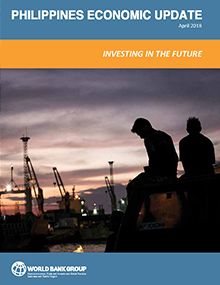 | April 2018: Investing in the FutureInvestments in infrastructure and education, skills, and health, are not only key to sustaining high growth but will also ensure that poor and vulnerable families have access to better job opportunities. Delivering inclusive economic growth through good jobs remains the country’s most pressing challenge. Highlights | Full Report (pdf) |
October 2017- Preserving Consistency and Policy Commitment
Get Key Findings | Download report
Sections in this edition:
- Part 1: Recent policy and economic developments – page 1
- Part 2: Outlook and Risks – page 32
- Part 3: Unlocking Mindanao’s potential – page 47
April 2017- Advancing the Investment Agenda
Get Key Findings | Download report
Sections in this edition:
- Recent Economic and Policy Developments – page 1
- Outlook and Risks – page 21
- Trade Competitiveness and Global Value Chains in the Philippines – page 28
October 2016- Outperforming the Region and Managing the Transition
Get Key Findings / Download report
Sections in this edition:
- Recent Economic and Policy Developments – page 1
- Outlook and Risks – page 17
- Increasing Tax Revenues Efficiently and Equitably – page 28
April 2016- Moving Full Speed Ahead: Accelerating Reforms to Create More and Better Jobs
Get Key Findings / Download report
Sections in this edition
• Recent Economic and Policy Developments - page 5
- Prospects and Risks - page 14
- Policies: A Retrospective and Forward Look on How to Create More and Better Jobs
• Medium-Term Reform Agenda: Enhancing competition - page 29
October 2015- Making Growth Work for Small Businesses
Get Key Findings / Download report
Sections in this edition
• Recent Economic and Policy Developments - page 1
- Prospects, Risks and Policies - page 14
• Medium-Term Reform Agenda: Enhancing competition - page 29
Special Focus
1. Real cost of starting and maintaining a business - page 45
2. Export transaction costs in the Philippines – page 60
January 2015- Making Growth Work for The Poor
Get Key Findings / Download report
Sections in this edition
Recent Economic and Policy Developments - page 1
• Prospects, Risks and Policies - page 10
• Medium-Term Reform Agenda: Enhancing competition - page 20
Special Focus
1. Congestion in Metro Manila and its impact on the economy - page 34
2. Potential power shortages in Luzon and the way forward – page 40
3. Reviving Philippine electronics exports – page 44
4. Liberalizing rice policy in the Philippines – page 54
5. Enhancing competition in the domestic shipping industry – page 63
August 2014- Investing in the Future
Get Key Findings / Download report (.pdf)
Sections in this edition
Recent Economic and Policy Developments - page 1
- Prospects, Risks and Policies - page 10
- Medium-Term Agenda: Tax Reform Package for more Inclusive Growth - page 14
- Recent Economic and Policy Developments – page 10
- Prospects , Risks and Policies – page 27
- Building Back Better after Typhoon Yolanda – page 37
- Medium term agenda: Working together to address the jobs challenge – page 47
- 1: Philippine tourism industry challenge – page 7
- 2: Impact Evaluation of the Kalahi – CIDSS – page 77
- Recent Economic and Policy Developments – Page 6
- Prospects and Policies – Page 21
- 1: Measuring changes in inventory and statistical discrepancy in the national income accounts – page 30
- 2: The Philippine Real Estate Market: A cause for concern? An update – page 33
- 3: The Comprehensive Tax Reform Program of 1986 and related tax administrative reforms – page 41
- 4: Impact Evaluation of the conditional cash transfer program – page 43
- 5: Procurement modernization strategy: an update – page 49
- Recent Economic and Policy Developments – p. 1
- Prospects and Policy Recommendations – p. 13
- Recent Economic and Policy Developments – p. 1
- Prospects – p. 12
- Recent Economic and Policy Developments – p. 1
- Prospects and Policy Recommendations – p. 13
- 1: Financing the Economic Cost of Disasters in the Philippines – p. 23
- 2: Cycles of Conflict and Displacement in Mindanao - - p 30
- 3: The Philippine Real Estate Market: A cause for concern? – page. 37
- 4: Stepping Up Disbursements by Improving Absorptive capacity in Agencies – p. 43
- Recent Economic and Policy Developments – p. 1
- Prospects and Policy Recommendations – p. 11
- 1: Raising Excise Taxes on Tobacco and Alcohol Products – p. 15
- 2: Philippine Exports: Where do they stand? – p. 24
- Recent Economic and Policy Developments - p. 1
- Prospects - p. 9
- 1: External Spillovers to Philippine Growth - p. 13
- 2: The 2012 Proposed National Budget - p. 17
- Recent Economic and Policy developments – p 1
- Prospects – p. 9
- Recent Economic and Policy Developments – p. 1
- Prospects – p. 9
- Recent Economic and Policy Developments – p. 1
- Prospects – p. 12
- Recent Economic and Policy Developments – p. 1
- Prospects – p. 8
- Selected special focus from recent quarterly updates – p. 26
- Recent Economic and Policy Developments – p. 1
- Prospects – p. 17
- Recent Economic Developments – p. 4
- Prospects – p. 12
- Recent Economic Developments – p. 3
- Polices – p. 11
- Prospects – p. 16
Recent Economic and Policy Developments – P. 3
Special Focus
- 1: The new purchasing power parities and poverty in the Philippines – page. 30
- 2: Inflation and the Poor page – p. 34
